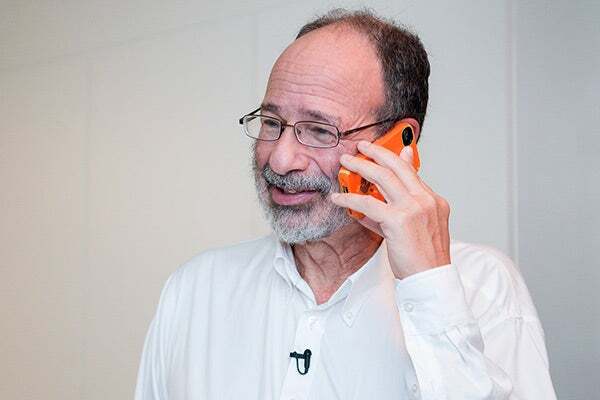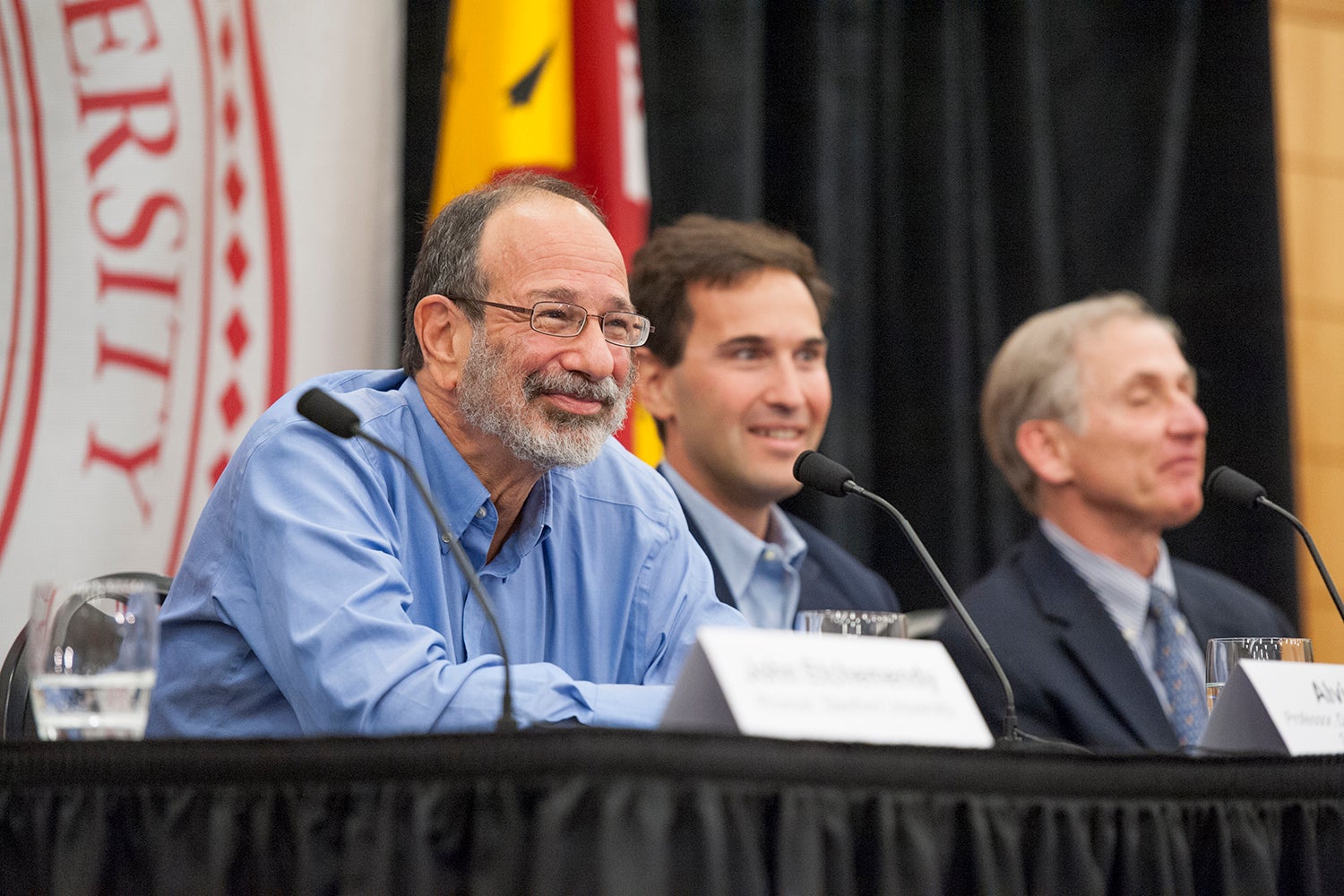Stanford visiting Professor Alvin Roth wins Nobel Memorial Prize in Economic Sciences
Harvard economist Alvin Roth, who is transitioning to Stanford, has been awarded the Nobel Memorial Prize in Economic Sciences for his work on market design. He shares the prize with Lloyd Shapley, professor emeritus at UCLA. Roth is a pioneer in the field of game theory and experimental economics and in their application to the design of new economic institutions.
Harvard economist Alvin Roth, who is transitioning to Stanford University, has been awarded the Nobel Memorial Prize in Economic Sciences for his work on market design. He shares the prize with Lloyd Shapley, a professor emeritus at the University of California, Los Angeles.

“Celebrating by telephone” his Nobel Prize win, Alvin Roth spent the morning talking with well-wishers and reporters from Rome to the White House. (Image credit: L.A. Cicero)
The Royal Swedish Academy of Sciences cited the researchers’ contributions to “the theory of stable allocations and the practice of market design” in naming them for the $1.2 million prize.
Roth, the McCaw Senior Visiting Professor of Economics at Stanford and a Stanford alumnus who will become a full faculty member at the start of 2013, is a pioneer in the field of game theory and experimental economics and in their application to the design of new economic institutions.
As one of the first “microeconomic engineers,” Roth has redesigned the market for kidney exchanges, the organization that matches medical residents with hospitals, public school choice systems and a variety of other institutions.
Stanford University Provost John Etchemendy, who described Roth’s recent arrival at Stanford as “fortuitous,” praised the economist as not only “an extraordinary researcher and teacher, admired worldwide by other economists,” but also “a heck of a nice human being.”
Roth, who still holds the George Gund Professorship of Economics and Business Administration at Harvard University and Harvard Business School, is the 19th Nobel laureate among Stanford’s current community of scholars. Since its founding, Stanford can claim 29 Nobel prizes but only 28 Nobel winners (Linus Pauling won twice, first for chemistry and then for peace.)
Reached at home shortly following the announcement, Roth said that he felt “good, the same as anyone who wins the Nobel Prize.”
“But at least in my case,” he went on, “this represents a lot of people’s work. It’s good for the field of market design.”
Stanford Economics Chair Jonathan Levin went further: “Everyone who does economics will be thrilled about this award, because Al is such a special researcher.”
Matchmaker
Bringing rigorous game theory approaches to bear on real-world problems, Roth has long been at the forefront of economic design. In particular, Roth has made a number of innovative applications of matching theory.

Nobel laureate Alvin Roth; Jonathan Levin, chair of the Department of Economics; and Richard Saller, dean of the School of Humanities and Sciences, meet with reporters at a press conference to discuss Roth’s work that led to the Nobel Prize. (Image credit: L.A. Cicero)
“I’ve always thought of economics as being not just part of the social sciences, but part of the humanities,” Roth said at Monday’s press conference at Stanford, “because it gives us a window into people’s lives at some of the biggest crossing points. When they get into schools and universities, when they get jobs, when they choose careers, when they get married – these are all matching markets.”
Roth’s major advance was to take abstract theorems, such as those devised by Roth’s fellow laureate Shapley and his collaborator, the late UC-Berkeley mathematician and economist David Gale, and see how they applied to the complexity of actual markets.
In the case of New York high schools, for instance, Roth faced a highly charged situation. At the time, prospective students ranked their top five school preferences, and the program attempted to give first choices to as many students as possible.
In practice, however, unless applicants gamed the system by carefully studding their lists with unpopular choices, they were likely to be locked out of all of their preferences and randomly assigned to schools with remaining vacancies. Poor matches were so common that over a third of New York eighth graders chose not to participate.
Roth, along with then-graduate student Parag Pathak and economist Atila Abdulkadiroglu, redesigned the New York matching system, using a refined version of a “deferred-acceptance algorithm” – a mathematical approach originally devised by Shapley and Gale to describe marriage options.
“Instead of having to think about how likely they are to get in, [parents] can start to think about things like which kindergarten teachers are good with shy boys or whatever it is that concerns them as a family,” said Roth.
The group’s solution not only brought participation up in the program to 93 percent, but inspired the Boston public school system to approach Roth as well.
Economics on the ground
Roth’s design of the New England Program for Kidney Exchange represents another large-scale, practical application of matching theory. In many cases, a healthy person would like to donate a kidney to a friend or loved one, but is medically incompatible. With paired kidney donation, however, that incompatible donor-recipient pair can trade their kidney to another mutually incompatible pair, while obtaining the kidney they need in return. The practice greatly increases the number of compatible kidneys available to a patient.
Richard Saller, the dean of the School of Humanities and Sciences, described it as “a particular pleasure” to hire an economist working on practical issues that show “basic research does have an importance in improving the world.”
“And it’s nice to have the Nobel Committee vindicate our taste in this,” he said.
Beyond his research on market design, Roth was one of the first researchers to conduct what is now known as “experimental economics” – laboratory-based investigations of economic theories.
“He could have easily been recognized by the Nobel Committee for his experimental economics research,” said Levin. “He’s one of the few economists who’d really made substantive contributions that could have earned him two Nobel prizes and not just one.”
Researcher and mentor
Roth famously dropped out of his Queens, N.Y., high school in his junior year. After taking weekend classes at Columbia University, he became a full-time Columbia student, earning an engineering degree before receiving master’s and doctoral degrees from Stanford in operations research in 1973 and 1974, respectively. He has since held professorships at the University of Illinois and the University of Pittsburgh.
In addition to his many academic publications, Roth is the author of several standard texts in bargaining theory, experimental economics and game theory. He has received numerous awards for teaching and research, including Alfred P. Sloan and Guggenheim fellowships, and is a member of the American Academy of Arts and Sciences and the National Bureau of Economic Research.
Explaining his return to Stanford, Roth cited the opportunity to be a colleague of his former students – including Stanford economics Professor Muriel Niederle.
Roth cut the press conference short to teach class, which, noted Etchemendy, “says something about his teaching and his mentoring.”
Although Roth slept through the initial 3:30 a.m. call from Sweden, overall, he didn’t seem too fazed by the prospect of handling big news at an early hour. He spent the morning “celebrating by telephone,” talking with well-wishers and reporters from Rome to the White House.
“Coffee is a big part of science,” he said.
